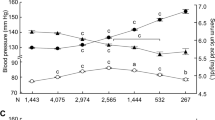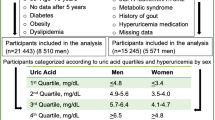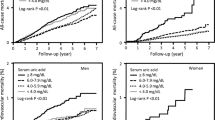Abstract
Epidemiologic studies suggest an independent positive association of elevated serum uric acid with essential hypertension. However, to date, limited information is available in the old population. In the present study, we included 832 unrelated Chinese nonagenarians/centenarians (269 men and 563 women; ranged in age from 90 to 108 years (mean, 94.6±4.0)). The mean serum uric acid level was 320 μmol l−1 (standard deviation 87 μmol l−1). After adjustment for age, body mass index, waist-to-hip ratio, smoking habits, tea habits, alcohol consumption, fasting plasma glucose, plasma lipids and serum creatinine, the odds ratio comparing the highest with lowest quartile of serum uric acid were 0.67 (95% confidence interval (CI), 0.33–1.21) and 1.36 (95% CI, 0.88–2.22) in men and women, respectively. When compared with normotensive subjects, we did not observe statistical higher serum uric acid levels in subjects with hypertension. In summary, we found that serum uric acid level is not directly correlated with hypertension among Chinese nonagenarians/centenarians.
This is a preview of subscription content, access via your institution
Access options
Subscribe to this journal
Receive 12 digital issues and online access to articles
$119.00 per year
only $9.92 per issue
Buy this article
- Purchase on Springer Link
- Instant access to full article PDF
Prices may be subject to local taxes which are calculated during checkout



Similar content being viewed by others
References
Fields LE, Burt VL, Cutler JA, Hughes J, Roccella EJ, Sorlie P . The burden of adult hypertension in the United States 1999–2000—a rising tide. Hypertension 2004; 44: 398–404.
Mahomed FA . On chronic Bright's disease, and its essential symptoms. Lancet 1879; I: 399–401.
Dollery CT, Duncan H, Schumer B . Hyperuricaemia related to treatment of hypertension. BMJ 1960; 2: 832–835.
Breckenridge A . Hypertension and hyperuricaemia. Lancet 1966; 1: 15–18.
Cannon PJ, Stason WB, Demartini FE, Sommers SC, Laragh JH . Hyperuricemia in primary and renal hypertension. N Engl J Med 1966; 275: 457–464.
Kahn HA, Medalie JH, Neufeld HN, Riss E, Goldbourt U . The incidence of hypertension and associated factors: the Israel ischemic heart disease study. Am Heart J 1972; 84: 171–182.
Selby JV, Friedman GD, Quesenberry CPJ . Precursors of essential hypertension: pulmonary function, heart rate, uric acid, serum cholesterol, and other serum chemistries. Am J Epidemiol 1990; 131: 1017–1027.
Hunt SC, Stephenson SH, Hopkins PN, Williams RR . Predictors of an increased risk of future hypertension in Utah. A screening analysis. Hypertension 1991; 17: 969–976.
Jossa F, Farinaro E, Panico S, Krogh V, Celentano E, Galasso R et al. Serum uric acid and hypertension: the Olivetti heart study. J Hum Hypertens 1994; 8: 677–681.
Taniguchi Y, Hayashi T, Tsumura K, Endo G, Fujii S, Okada K . Serum uric acid and the risk for hypertension and Type 2 diabetes in Japanese men: the Osaka Health Survey. J Hypertens 2001; 19: 1209–1215.
Masuo K, Kawaguchi H, Mikami H, Ogihara T, Tuck ML . Serum uric acid and plasma norepinephrine concentrations predict subsequent weight gain and blood pressure elevation. Hypertension 2003; 42: 474–480.
Nakanishi N, Okamoto M, Yoshida H, Matsuo Y, Suzuki K, Tatara K . Serum uric acid and risk for development of hypertension and impaired fasting glucose or Type II diabetes in Japanese male office workers. Eur J Epidemiol 2003; 18: 523–530.
Nagahama K, Inoue T, Iseki K, Touma T, Kinjo K, Ohya Y et al. Hyperuricemia as a predictor of hypertension in a screened cohort in Okinawa, Japan. Hypertens Res 2004; 27: 835–841.
Alper Jr AB, Chen W, Yau L, Srinivasan SR, Berenson GS, Hamm LL . Childhood uric acid predicts adult blood pressure: the Bogalusa Heart Study. Hypertension 2005; 45: 34–38.
Sundstrom J, Sullivan L, D'Agostino RB, Levy D, Kannel WB, Vasan RS . Relations of serum uric acid to longitudinal blood pressure tracking and hypertension incidence. Hypertension 2005; 45: 28–33.
Shankar A, Klein R, Klein BE, Nieto FJ . The association between serum uric acid level and long-term incidence of hypertension: population-based cohort study. J Hum Hypertens 2006; 20: 937–945.
Mellen PB, Bleyer AJ, Erlinger TP, Evans GW, Nieto FJ, Wagenknecht LE et al. Serum uric acid predicts incident hypertension in a Biethnic Cohort: the Atherosclerosis Risk in Communities Study. Hypertension 2006; 48: 1037–1042.
Krishnan E, Kwoh CK, Schumacher HR, Kuller L . Hyperuricemia and incidence of hypertension among men without metabolic syndrome. Hypertension 2007; 49: 298–303.
Feig DI, Johnson RJ . Hyperuricemia in childhood primary hypertension. Hypertension 2003; 42: 247–252.
Forman JP, Choi H, Curhan GC . Plasma uric acid level and risk for incident hypertension among men. J Am Soc Nephrol 2007; 18: 287–292.
Dang A, Zhang Y, Liu G, Chen G, Song W, Wang B . Effects of losartan and irbesartan on serum uric acid in hypertensive patients with hyperuricaemia in Chinese population. J Hum Hypertens 2006; 20: 45–50.
Rayner BL, Trinder YA, Baines D, Isaacs S, Opie LH . Effect of losartan versus candesartan on uric acid, renal function, and fibrinogen in patients with hypertension and hyperuricemia associated with diuretics. Am J Hypertens 2006; 19: 208–213.
Chobanian AV, Bakris GL, Black HR, Cushman WC, Green LA, Izzo JL et al. Seventh report of the joint national committee on prevention, detection, evaluation, and treatment of high blood pressure. Hypertension 2003; 42: 1206–1252.
Alberti KG, Zimmet P, Shaw J . Metabolic syndrome—a new world-wide definition. A Consensus Statement from the International Diabetes Federation. Diabet Med 2006; 23: 469–480.
Domagk GF, Schlicke HH . A colorimetric method using uricase and peroxidase for the determination of uric acid. Anal Biochem 1968; 22: 219–224.
Onat A, Uyarel H, Hergenc G, Karabulut A, Albayrak S, Sari I et al. Serum uric acid is a determinant of metabolic syndrome in a population-based study. Am J Hypertens 2006; 19: 1055–1062.
Rho YH, Woo JH, Choi SJ, Lee YH, Ji JD, Song GG . Association between serum uric acid and the Adult Treatment Panel III-defined metabolic syndrome: results from a single hospital database. Metabolism 2008; 57: 71–76.
Ford ES, Li C, Cook S, Choi HK . Serum concentrations of uric acid and the metabolic syndrome among US children and adolescents. Circulation 2007; 115: 2526–2532.
Maxwell AJ, Bruinsma KA . Uric acid is closely linked to vascular nitric oxide activity: evidence for mechanism of association with cardiovascular disease. J Am Coll Cardiol 2001; 38: 1850–1858.
Jaramillo M, Naccache PH, Olivier M . Monosodium urate crystals synergize with IFN-{gamma} to generate macrophage nitric oxide: involvement of extracellular signal-regulated kinase 1/2 and NF-{kappa}B. J Immunol 2004; 172: 5734–5742.
Kang DH, Nakagawa T, Feng L, Watanabe S, Han L, Mazzali M et al. A role for uric acid in the progression of renal disease. J Am Soc Nephrol 2002; 13: 2888–2897.
Kang DH, Park SK, Lee IK, Johnson RJ . Uric acid-induced C-reactive protein expression: implication on cell proliferation and nitric oxide production of human vascular cells. J Am Soc Nephrol 2005; 16: 3553–3562.
Watanabe S, Kang D-H, Feng L, Nakagawa T, Kanellis J, Lan H et al. Uric acid, hominoid evolution, and the pathogenesis of salt-sensitivity. Hypertension 2002; 40: 355–360.
Kang DH, Han L, Ouyang X, Kahn AM, Kanellis J, Li P et al. Uric acid causes vascular smooth muscle cell proliferation by entering cells via a functional urate transporter. Am J Nephrol 2005; 25: 425–433.
Nakagawa T, Hu H, Zharikov S, Tuttle KR, Short RA, Glushakova O et al. A causal role for uric acid in fructose-induced metabolic syndrome. Am J Physiol Renal Physiol 2006; 290: F625–F631.
Johnson RJ, Kang D-H, Feig D, Kivlighn S, Kanellis J, Watanabe S et al. Is there a pathogenetic role for uric acid in hypertension and cardiovascular and renal disease? Hypertension 2003; 41: 1183–1190.
Ruggiero C, Cherubini A, Ble A, Bos AJG, Maggio M, Dixit VD et al. Uric acid and inflammatory markers. Eur Heart J 2006; 27: 1174–1181.
Sanchez-Lozada LG, Nakagawa T, Kang DH, Feig DI, Franco M, Johnson RJ et al. Hormonal and cytokine effects of uric acid. Curr Opin Nephrol Hypertens 2006; 15: 30–33.
Ishizaka N, Ishizaka Y, Toda E, Hashimoto H, Nagai R, Yamakado M . Higher serum uric acid is associated with increased arterial stiffness in Japanese individuals. Atherosclerosis 2007; 192: 131–137.
Wang TJ, Gona P, Larson MG, Levy D, Benjamin EJ, Tofler GH et al. Multiple biomarkers and the risk of incident hypertension. Hypertension 2007; 49: 432–438.
Mazzali M, Kanellis J, Han L, Feng L, Xia Y-Y, Chen Q et al. Hyperuricemia induces a primary renal arteriolopathy in rats by a blood pressure-independent mechanism. Am J Physiol Renal Physiol 2002; 282: F991–F997.
Fuiano G, Sund S, Mazza G, Rosa M, Caglioti A, Gallo G et al. Renal hemodynamic response to maximal vasodilating stimulus in healthy older subjects. Kidney Int 2001; 59: 1052–1058.
Brand FN, McGee DL, Kannel WB, Stokes III J, Castelli WP . Hyperuricemia as a risk factor of coronary heart disease: the Framingham Study. Am J Epidemiol 1985; 121: 11–18.
Kannel WB . Metabolic risk factors for coronary heart disease in women: perspective from the Framingham Study. Am Heart J 1987; 114: 413–419.
Casiglia E, Spolaore P, Ginocchio G, Colangeli G, Di Menza G, Marchioro M et al. Predictors of mortality in very old subjects aged 80 years or over. Eur J Epidemiol 1993; 9: 577–586.
Kaplan NM, Opie LH . Controversies in cardiology 2—controversies in hypertension. Lancet 2006; 367: 168–176.
Ames BN, Cathcart R, Schwiers E, Hochstein P . Uric acid provides an antioxidant defense in humans against oxidant- and radical-caused aging and cancer: a hypothesis. PNAS 1981; 78: 6858–6862.
Rosell M, Regnstrom J, Kallner A, Hellenius ML . Serum urate determines antioxidant capacity in middle-aged men—a controlled, randomized diet and exercise intervention study. J Intern Med 1999; 246: 219–226.
Maxwell SR, Thomason H, Sandler D, Leguen C, Baxter MA, Thorpe GH et al. Antioxidant status in patients with uncomplicated insulin-dependent and non-insulin-dependent diabetes mellitus. Eur J Clin Invest 1997; 27: 484–490.
Nieto FJ, Iribarren C, Gross MD, Comstock GW, Cutler RG . Uric acid and serum antioxidant capacity: a reaction to atherosclerosis? Atherosclerosis 2000; 148: 131–139.
Paolisso G, Barbieri M, Bonafe M, Franceschi C . Metabolic age modelling: the lesson from centenarians. Eur J Clin Invest 2000; 30: 888–894.
Acknowledgements
This work was supported by grants from the project of Science and Technology Bureau of Sichuan Province (2006Z09-006-4), Construction Fund for Subjects of West China Hospital of Sichuan University (XK05001). The authors thank the staff of the Department of Geriatrics Medicine, West China Hospital and Dujiangyan Hospital, and all participants (as well as their legal proxies) for their great contribution. Mr Guangjian Liu and Mr Wei Ji are also acknowledged for their statistics assistance.
Author information
Authors and Affiliations
Corresponding author
Additional information
Conflict of interest
None.
Rights and permissions
About this article
Cite this article
Lu, Z., Dong, B., Wu, H. et al. Serum uric acid level in primary hypertension among Chinese nonagenarians/centenarians. J Hum Hypertens 23, 113–121 (2009). https://doi.org/10.1038/jhh.2008.104
Received:
Revised:
Accepted:
Published:
Issue Date:
DOI: https://doi.org/10.1038/jhh.2008.104
Keywords
This article is cited by
-
A frailty index based on routine laboratory data predicts increased risk of mortality in Chinese community-dwelling adults aged over 55 years: a five-year prospective study
BMC Geriatrics (2022)
-
Association between serum uric acid and major chronic diseases among centenarians in China: based on the CHCCS study
BMC Geriatrics (2021)
-
Interaction between body mass index and serum uric acid in relation to blood pressure in community-dwelling Japanese men
Clinical Hypertension (2018)
-
The prevalence of hyperuricemia and its correlates in an inland Chinese adult population, urban and rural of Jinan
Rheumatology International (2013)
-
Uric acid and fibrinogen: age-modulated relationships with blood pressure components
Journal of Human Hypertension (2011)



